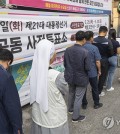- California Assembly OKs highest minimum wage in nation
- S. Korea unveils first graphic cigarette warnings
- US joins with South Korea, Japan in bid to deter North Korea
- LPGA golfer Chun In-gee finally back in action
- S. Korea won’t be top seed in final World Cup qualification round
- US men’s soccer misses 2nd straight Olympics
- US back on track in qualifying with 4-0 win over Guatemala
- High-intensity workout injuries spawn cottage industry
- CDC expands range of Zika mosquitoes into parts of Northeast
- Who knew? ‘The Walking Dead’ is helping families connect
S. Korea’s new COVID-19 cases below 10,000 amid waning omicron wave
South Korea’s new COVID-19 cases fell below 10,000 Friday, continuing a gradual decline, as the country is working to return to pre-pandemic normalcy.
The country added 9,315 COVID-19 infections, including 34 cases from overseas, bringing the total caseload to 18,209,650, the Korea Disease Control and Prevention Agency (KDCA) said.
It is the first time in nearly five months that the figure for Friday fell below the 10,000 level.
South Korea has seen a gradual decline in total infections in recent weeks after the omicron-driven worst virus wave that pushed up the daily count to over 620,000 in mid-March.
The country added 18 COVID-19 deaths Friday, bringing the death toll to 24,341. The fatality rate stood at 0.13 percent.
The number of critically ill patients came to 107, compared with 106 the previous day.
As of 9 p.m., the country had added 8,098 new cases, down 815 from the same time a day earlier, according to local governments and health authorities.
As of Thursday, 44.6 million people, or 86.9 percent of the population, had completed the full two-dose vaccinations, and 33.33 million, representing 64.9 percent, had received their first booster shots.
More than 4.23 million people, or 8.2 percent of the population, had gotten their second booster shots, the KDCA said.

People pass a COVID-19 testing station for arrivals at Incheon International Airport, west of Seoul, on June 8, 2022. (Yonhap)
In a move to better analyze the virus, the government will carry out a large-scale survey on long-term effects of the new coronavirus, Prime Minister Han Duck-soo said.
The survey will involve about 10,000 people, and the analysis of so-called long COVID is expected to be available within the year, the KDCA said, adding that it will form the basis for new guidelines for the treatment of post COVID-19 conditions.
According to government data, some 19.1 percent of people who had been infected with the virus have visited medical clinics due to long-term effects. Common symptoms include fatigue, shortness of breath, and sleep problems.
The government will also launch an advisory committee under the prime minister’s office on responses to infectious diseases.
The new Yoon Suk-yeol government has stressed the need to devise “science-based” quarantine measures on the back of scientific data and analysis to better respond to the prolonged virus situation.
The government is also pushing to secure 5,000 medical centers across the nation that will handle COVID-19 cases in a comprehensive manner from testing to prescription and treatment.
On Thursday, KDCA chief Peck Kyong-ran called for social consensus on whether to lift the mandatory seven-day self-isolation period for COVID-19 patients, noting the quarantine-free scheme for those infected is bound to spark the spread of the virus to damage public health and raise financial and other social burdens.
The KDCA is expected to make a decision on the possible lifting of the mandatory seven-day self-isolation period for COVID-19 patients next week.
The public health agency will assess the pandemic trend and other related factors before deciding whether to expand the inoculation scheme of a second COVID-19 booster shot, she said.
Currently, a fourth shot is reserved for people aged 60 and older and those in senior care hospitals and related facilities.












